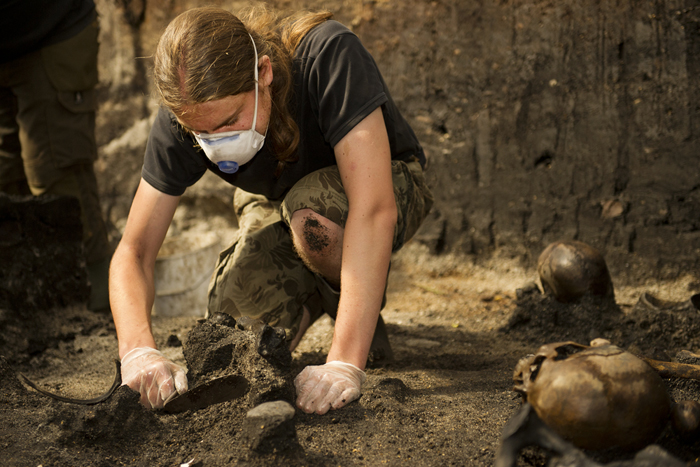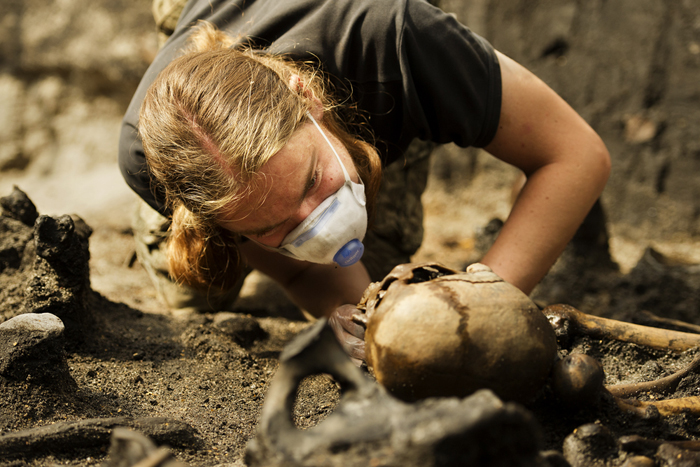In Photos: Boneyard of Iron Age Warriors
Lead Archaeologist

Mads Kähler Holst, the project manager at the Alken Enge dig, stands in front of the scattered bones of Iron Age warriors. At least 60 individual skeletons or parts of skeletons have been found at the site, only a small portion of the bones likely buried in the area, according to Holst.
Excavating An Ancient Battlefield

Arjen Heijnis excavates a skull at Alken Enge. The bones at the site show signs of trauma from the battlefield, including wounds from spears, swords and axes. Some skulls were crushed. After death, wolves, dogs and badgers gnawed on the bones.
A Warrior's Remains

Arjen Heijnis moves in close to remove a skull from the ground. After six months of being scavenged by animals, the bones were gathered and sorted and any remaining flesh was scraped away. The bone mutilation may have been part of a closure ritual to end the war.
Planning a Dig

Ejvind Hertz and Uffe Rasmussen discuss the excavation at Alken Enge. The season's excavations continue through August 8, 2014. Archaeologists have dug several trenches in various areas around the site.
Defeated Warriors

An ancient warrior's skull looks almost plaintive against a backdrop of limb bones. Many of the bones appear to have been sorted by type before they were dumped in the lake. All of the bodies found are male.
Battlefield Excavations

Scaffolding and surveying equipment in one of the trenches at the Alken Enge excavation site. The discovery of the bones at Alken Enge first made headlines in 2012. Among the bones were ceramics and animal sacrifices, indicating a possible religious aspect to the ritual mutilation of the skeletons.
Sifting through History

"We have trenches going through different areas, so we know we are only touching on a small part of what is actually there," said Mads Kähler Holst, project manager at the dig and head of the department of archaeology at the Moesgård Museum in Denmark.
Sign up for the Live Science daily newsletter now
Get the world’s most fascinating discoveries delivered straight to your inbox.
Recording the Past

Pernille Thulstrup and Peter Jensen work at the Alken Enge site.
"It seems that this was a holy site for a pagan religion — a sacred grove — where the victorious conclusion of major battles was marked by the ritual presentation and destruction of the bones of the vanquished warriors," Mads Kähler Holst, project director, said in a statement.
Pelvises on a stick

Four pelvises strung on a stick, one of the stranger finds at Alken Enge. This discovery might indicate that bones were displayed in some way before being dumped in Lake Mossø. The bones appeared to have been threaded on the stick after the flesh was removed, excavation field director Ejvind Hertz of Skanderborg Museum said in a statement. [Read full story]
Searching for Bones

A researcher stretches out from the excavation scaffolding to clear dirt. No other examples of post-battle mutilation have been found in this region of Europe, Holst told Live Science.

Stephanie Pappas is a contributing writer for Live Science, covering topics ranging from geoscience to archaeology to the human brain and behavior. She was previously a senior writer for Live Science but is now a freelancer based in Denver, Colorado, and regularly contributes to Scientific American and The Monitor, the monthly magazine of the American Psychological Association. Stephanie received a bachelor's degree in psychology from the University of South Carolina and a graduate certificate in science communication from the University of California, Santa Cruz.









